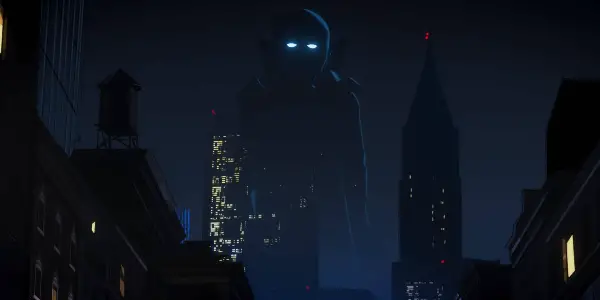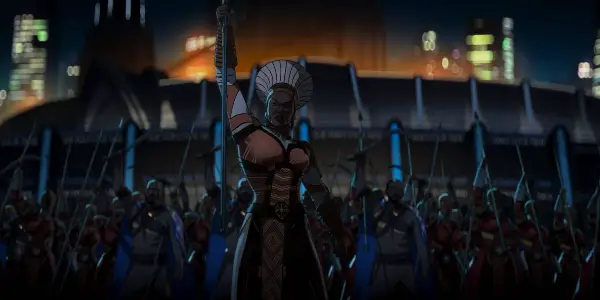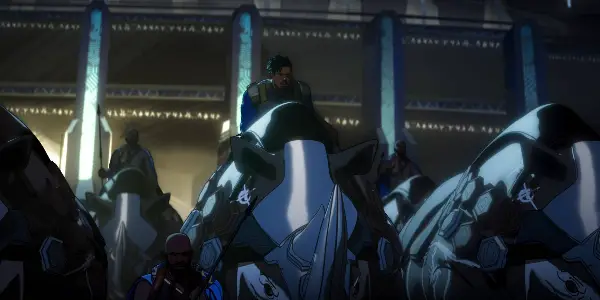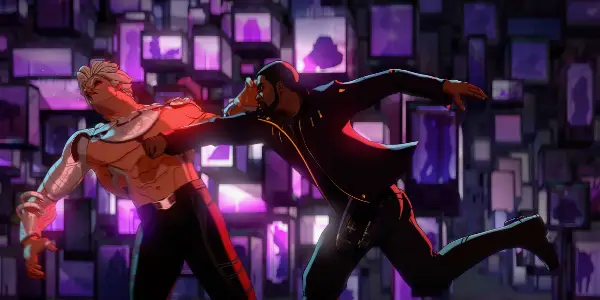The Diversity Promise Of Marvel’s WHAT IF…?

Film critic, Ithaca College and University of St Andrews graduate,…
For diehard fans, Marvel’s What If…? can be a miraculous and marvelously entertaining series. Its joy and creativity spring from its anthology format, which allows the show to offer plenty of surprises with its short-form storytelling. None of those surprises — spoiler alert, by the way — really affect the fabric of the Marvel Cinematic Universe as we know it, even if the hyper-charged, action-packed season one finale shows that in the MCU, the multiverse is malleable.
While the purpose of What If…? may be to prime the fanbase for multiverse madness ahead of Spider-Man: No Way Home and the Doctor Strange sequel, its secondary function is one of image and branding. Marvel’s slate — especially the first three phases, whose films What If…? season one uses as its playground — has drawn criticism for a lack of diversity; with few exceptions, it’s white guys as far as the eye can see. Marvel tended to relegate its female characters and nonwhite heroes to supporting roles, only rarely giving them the spotlight, and that’s a tradition What If…? tries to buck.
What If… Women Got To Punch Nazis Too
Each episode of What If…? (for the most part) deals with its own reality, as the ominous and big-headed Watcher (Jeffrey Wright) tells us in the introduction. Each installment, then, is allowed to exist independently. That means that anyone can die and anyone can become a hero. In that way, each episode offers a sort of retconning of a classic MCU film, if only for 20 to 30 minutes at a time.
Of the nine episodes in season one, each one except Thor’s and Doctor Strange’s assigns a new protagonist to its respective Marvel story. In episode one, Peggy Carter (Hayley Atwell) takes the super-soldier serum instead of Steve Rogers (Josh Keaton). In episode two, T’Challa (Chadwick Boseman) is taken by the Ravagers instead of Peter Quill (Brian T. Delaney). Additionally, Djimon Hounsou’s character, Korath, is bumped up to sidekick status, a major promotion from the disposable muscle role he’s assigned in the original Guardians of the Galaxy.
In episode three, when the Avengers start dying mysteriously, Nick Fury (Samuel L. Jackson) and Natasha Romanoff (Lake Bell) become the heroes of the story instead of Earth’s Mightiest Heroes. In episode five, the zombie episode, a large cast of characters gives Okoye (Danai Gurira), Hope Van Dyne (Evangeline Lilly), and T’Challa as much screentime as more staid MCU characters like Spider-Man (Hudson Thames) and Bucky Barnes (Sebastian Stan). Episode six makes Erik Killmonger (Michael B. Jordan) the hero of Iron Man instead of Tony Stark (Mick Wingert) and includes most of the Wakandan cast, episode eight centers on Black Widow and Hawkeye (Jeremy Renner) in an Ultron-induced end time, and the finale creates a multidimensional Avengers team comprising, among others, Star-Lord T’Challa, Killmonger, Black Widow, and Peggy Carter, like the diverse inverse of the team we’re served in the films. Even the ’90s pastiche Party Thor episode gives Maria Hill (Cobie Smulders), Jane Foster (Natalie Portman), and Captain Marvel (Brie Larson) as much play as Thor (Chris Hemsworth), effectively balancing out the hyperactive party guy energy with a predominantly female supporting cast. The show, too, is overseen by The Watcher, What If…? casting Wright in the role of an omniscient, nearly all-powerful being.

These aren’t merely aesthetic changes, though they easily could have been. Showrunner A.C. Bradley extricates the drama from these casting changes — episode one, for example, spends much of its first half with military brass talking down to Peggy, saying that women have no place on the frontlines. Episode six uses Killmonger to tell a story broader in scope than Tony’s, traveling to Wakanda for a third-act battle scene and exploring Killmonger’s revolutionary politics from Black Panther. Episode seven uses its hokey ’90s premise and impudent, frat-boy version of the God of Thunder to examine the misogyny of hypermasculinity, frat culture, and ’90s college party comedies as a genre.
Often, by supplanting the white male hero with a woman or a non-white character, many of the problems of the original narratives are resolved faster and with greater efficiency. Captain Carter saves Bucky from falling off the train, circumventing his transformation into the Winter Soldier. She’s faster, stronger, more agile than Steve at first, owing to her professional training as an agent. Once Tony promotes Killmonger in episode six, Killmonger immediately susses out that Obidiah Stane (Kiff VandenHeuvel) is a traitor and has him removed from Stark Industries.
Even the zombie’s episode, in which the characters are more or less fodder for the undead, valorizes its women over the men. They’re given heroic death scenes or poignant ends while the men (and Vision, voiced by Paul Bettany) are mostly morally flawed, given abrupt shock deaths or treated simply as comic relief. Time and again, the series seems to suggest that the white guys we saw in the movies were maybe not the right ones for the job, that greater diversity in the MCU would have solved a lot of problems before they got out of hand.
The most extreme example comes from the Guardians episode, in which T’Challa has successfully convinced Thanos not to become a genocidal tyrant and instead converted him to the heroes’ side — all apparently with the power of a good argument. He’s also convinced the Ravagers to embrace a moral compass. Physically, he’s also stronger than Peter Quill — this version of Star-Lord holds his own against Ego (Kurt Russell) and then, later, a universe-eating, Infinity Stones–tricked-out Ultron (Ross Marquand) without great difficulty. He can also apparently swipe the soul stone out of a vibranium suit of armor like snatching an egg from a nest.
The series successfully delivers its feminist themes, too, giving Captain Carter’s, Okoye’s, and Black Widow’s storylines careful consideration and not only showing the gender adversity they face on their paths, but also showing more nuanced aspects of feminism, such as professional friendships between women, maternal warrior spirit, and the ability to stab a dude really hard with a spear. It’s a far cry from the superficial “Don’t worry, she’s got help” scene from Avengers: Endgame.
Phase Four
To the studio’s credit, Marvel made several attempts to diversify its roster of heroes leading up to Avengers: Endgame, with standalone films for its first Black superhero, Black Panther; and for Captain Marvel, the first woman to headline her own MCU property. What If…? is part of the studio’s Phase Four, which seems to be all about diversification and representation on-screen. So far post-Endgame, we’ve had our second female-led MCU film, our first Chinese-American superhero (working alongside a mostly East Asian and Asian-American cast), and WandaVision, which is the most substantial female-led property the studio’s heretofore produced.

Now we have The Eternals, with Marvel’s most diverse lineup of heroes yet; a Thor movie in which Jane Foster and Valkyrie (Tessa Thompson) seem to be taking larger roles; a sequel to Captain Marvel starring Monica Rambeau (Teyonah Parris) and Miss Marvel (Iman Vellani); and a sequel to Black Panther. On Disney+, we’ll also have a series focusing on Miss Marvel, She-Hulk (Tatiana Maslany), Ironheart (Dominique Thorne), and James Rhodes (Don Cheadle), and one devoted to Wakanda. No more baby steps.
Diversity in film is a buzzy phrase now for good reason, and it’s certainly an important consideration with big-budget studio filmmaking. Ultimately, the sight of Ramonda, Queen Mother of Wakanda (Angela Bassett) straddling two Stark drones and wrenching a spear out through both of their craniums and screaming isn’t a visual intended for me, a white guy, but for children who see in the Queen Mother, a figure who looks like them, or who looks like their mothers, or friends’ mothers, or aunts or grandparents — increased positive representation of underrepresented groups on-screen affects the way fans from these diasporas see themselves, their lives, and their futures. Furthermore, we’ve seen a century of overwhelmingly negative or regressive depictions of women, Black people, and especially Black women, as well as nearly every other nonwhite, nonheterosexual, nonbinary, or nonmale group, in Hollywood filmmaking, and Marvel films are literally some of the most popular, profitable, and widely seen films in the world. What If…? is at least trying to right the ship.
But at the same time, for all the strides in on-screen diversity Disney has made, these are all self-imposed limitations. Marvel didn’t lead with Black Panther and Captain Marvel, though they could have — instead, their releases were carefully calibrated after the MCU had attained a certain degree of success and profitability on the backs of white men, who are presumably seen by the Disney suits to be more reliable box-office draws. With Disney, diversity feels market-tested to ensure that progress on-screen does not come at the expense of the bottom line. Just remember how many LGBTQ+ characters Disney has introduced in its live-action films whose hugs or kisses could be easily removed for international releases.
A cynical read of Disney’s business strategy — because for Disney, cinema is a business, after all — would suggest that after Endgame, after the studio produced 22 films, including some of the highest-grossing films ever made, it began trading in diversity as a means to bolster its box office returns, using nonwhite and female superheroes as a selling point to show consumers that, however many films in, the product is different this time.
In that vein, What If…? can become something of an exercise in guilt for a studio whose fanbase has been clamoring for more diverse heroes and more out-of-the-box storytelling for years. The Disney+ anthology series is the perfect medium for such experimentation, for such image rejuvenation: Being relegated to a streaming service ensures that only the most committed fans will seek the show out, especially since What If..? isn’t being marketed as a key part of the MCU timeline the same way that WandaVision, The Falcon and the Winter Soldier, and Loki had been. I’d imagine that many casual Marvel fans are comfortable with skipping the show altogether.

Additionally, the broader stakes for What If…? are very low; the writers can do whatever they want without worrying about their changes bleeding over into the mainline MCU films, and when they do something truly revolutionary, a la Captain Carter or Star-Lord T’Challa, the changes tend to last for an episode and then that’s it. When upcoming films explore the multiverse — and they will — and elements of What If…? are inevitably pulled in, Marvel bandleader Kevin Feige and his creative team can pick and choose what they want to adopt from the series, likely based on which characters got the best fan reception. I wouldn’t be surprised, for instance, if Captain Carter or our dark-wizard Doctor Strange (Benedict Cumberbatch) found their way into the live-action films. But we’ll never see, for example, an all-Black Avengers lineup in the mainline MCU, or a female superhero film where the script doesn’t keep insisting that it’s radical for letting a woman beat up the boys.
The Profit Motive And The Multiverse
This cynical interpretation of What If…? is what I assumed while I was watching the first episodes, that the show is more lip service than a genuine next step for the studio, a way to satiate the fans while maintaining the white bread natural order.
But the changes, of course, don’t stop when the credits roll on an episode. Captain Carter and Star-Lord T’Challa return for the season finale, and Carter is set up for more episodes next season. And while the subversive diversity of What If…? on its own might inspire this “baby steps” response, the rest of Phase Four definitely indicates that Marvel is undergoing a significant image change for its core team of heroes.
Not only has Disney embraced diversity on the big screen, but its longer-form Disney+ shows, which give their characters more depth and screentime than they can be afforded in three live-action films, will be exploring Black superheroes like Ironheart and War Machine and delivering more Wakanda content. And the creators behind these new films and shows are, for the most part, exciting new voices we haven’t heard in the MCU before, like Chloé Zhao, Bisha K. Ali, and Yassir Lester. And Taika Waititi, the resident king of insinuating that all our favorite MCU characters are bisexual, is back as well. The status quo appears to have changed for the better.

For the record, on the whole, I liked What If…? a lot and tend to enjoy more Marvel films than I don’t. Despite knowing that Disney is a corporate entity focused on profitability over politics and despite going into What If…? thinking the show would be little more than fan service, I came away legitimately excited, not just for the next films from the MCU but also for the creative direction of the franchise.
Conclusion: Being Cynical
It’s easy to be cynical about Marvel’s approach to diversity — because Marvel’s Black- and female-led superhero films would have not been released yet, What If…? is simply a concept that wouldn’t have worked five years ago. But as Disney’s hold on the superhero market tightens, the studio seems to be genuinely interested in telling more diverse stories with nonwhite, nonmale creative teams steering the ship, even if the incentive is profit. And in What If…?, those stories are often heartfelt, moving, and well-told. “What If… T’Challa Became a Star-Lord?” is for me and many others a clear series highlight, blending the representation of Marvel’s Black heroes with genre experimentation and often bizarre storytelling.
The show also levels an aptly critical eye against the white characters we’ve been told are the good guys. It’s not a coincidence that Tony Stark dies in nearly every episode he’s in, or that Hank Pym (Michael Douglas), Doctor Strange, and Thor take turns playing the villain.
Diversity in Marvel films and shows not only improves the kinds of stories that are told, but it also helps to cement new heroes in popular culture. It’s fun to see T’Challa do cool stuff, and that’s a promise that What If…? delivers on. In its own “what if…?” scenario, the series suggests an alternate reality in which the MCU we know had been led by Black and female characters from the get-go. Bradley and her team of writers clearly love these characters, but more than that, the reason What If…? succeeds and does such an enviable job of retconning Marvel’s films is that Bradley genuinely seems to understand the limits of the MCU as much as she knows what the MCU could and should be doing with the immense scope of storytelling it has at its fingertips.
What do you think of Marvel’s What If…? Let us know in the comments below.
Does content like this matter to you?
Become a Member and support film journalism. Unlock access to all of Film Inquiry`s great articles. Join a community of like-minded readers who are passionate about cinema - get access to our private members Network, give back to independent filmmakers, and more.
Film critic, Ithaca College and University of St Andrews graduate, head of the "Paddington 2" fan club.












